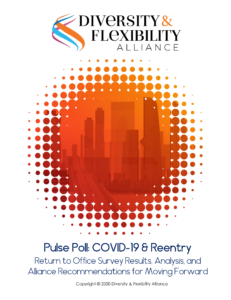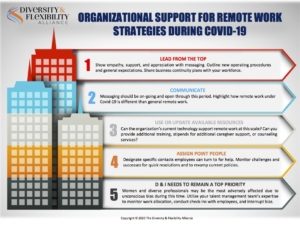Washington, DC – July 10, 2020 – Today the Diversity & Flexibility Alliance released highlights from its Pulse Poll: COVID-19 and Re-Entry that emphasized the need for continued focus on inclusion for all employees in office re-entry practices.
 The poll was developed to uncover important data and trends related to the approach law firms and corporations are taking during this initial office re-opening phase and to provide advice on best practices. The poll’s questions were related to office re-opening task forces, guidelines regarding which employees could continue to work remotely once states re-open, and the types of resources and training provided to employees.
The poll was developed to uncover important data and trends related to the approach law firms and corporations are taking during this initial office re-opening phase and to provide advice on best practices. The poll’s questions were related to office re-opening task forces, guidelines regarding which employees could continue to work remotely once states re-open, and the types of resources and training provided to employees.
“While many firms and corporations have pledged their commitment to diversity and inclusion in recent years, their actions as they re-open their offices during the COVID-19 crisis will demonstrate their sincerity and have a meaningful impact on all employees,” said Manar Morales, President & CEO of the Diversity & Flexibility Alliance. “While I am pleased to see that a significant number of firms and corporations are focusing on inclusion during office re-openings, I hope that more organizations will follow suit. It’s critical that firms and corporations incorporate D&I professionals in their Office Reopening Task Force, allow requests to continue to work remotely to be “reason-neutral,” and provide necessary virtual trainings,” she added.
The Pulse Poll revealed several noteworthy highlights, including:
- The vast majority of participants (85.3%) have a task force focused on re-entry and nearly two-thirds of these task forces include a Diversity & Inclusion professional.
- A significant share of participant organizations will allow all of their employees to work remotely (35.3%) and will use a “reason-neutral” process to determine who can work remotely (44.1%). However, too many organizations are still limiting which employees can work remotely based upon their function and/or their risk level.
- A significant share are planning on launching the following trainings: Best Practices for Working Remotely (38.2%, or 13 of 34), Best Practices for Leading Remote Teams (32.4%, or 11 of 34), and Unconscious Bias (23.5%, or 8 of 34). Only a small number (3 of 34, or 8.8%) indicated they will have no trainings to support re-entry.
The Pulse Poll: COVID-19 AND Re-Entry consisted of responses from 34 law firms and corporations between May 14 and June 5, 2020. The complete report will be available exclusively to members of the Diversity & Flexibility Alliance as well as poll participants.
The Diversity and Flexibility Alliance is a think tank that collaborates with organizations to develop non-stigmatized flexible work policies that promote inclusive work cultures and help to advance more women into leadership positions. The Alliance provides practical research-based solutions, training workshops, and strategic advisory services that increase organizational effectiveness through diversity and flexibility.



 This article by
This article by  The poll was developed to uncover important data and trends related to the approach law firms and corporations are taking during this initial office re-opening phase and to provide advice on best practices. The poll’s questions were related to office re-opening task forces, guidelines regarding which employees could continue to work remotely once states re-open, and the types of resources and training provided to employees.
The poll was developed to uncover important data and trends related to the approach law firms and corporations are taking during this initial office re-opening phase and to provide advice on best practices. The poll’s questions were related to office re-opening task forces, guidelines regarding which employees could continue to work remotely once states re-open, and the types of resources and training provided to employees.